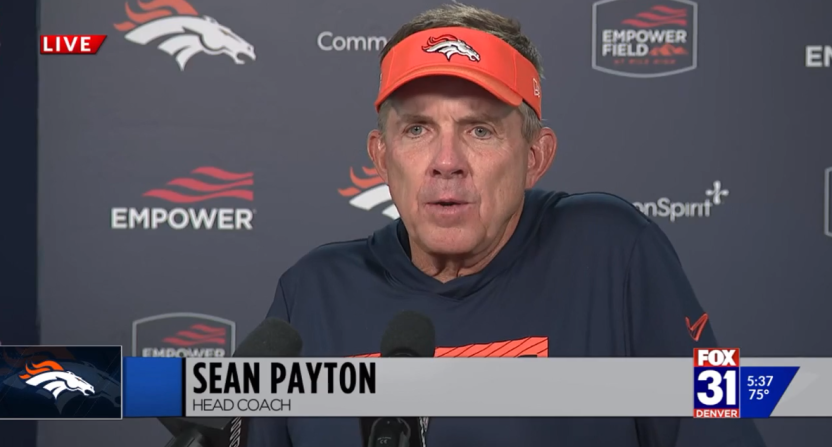For the second time in as many seasons under coach Sean Payton, the Denver Broncos are 0-2. And while there’s a lot about the game to second guess from Denver’s perspective, the decision to kick the ball deep down seven late in the game is the most glaring.
A Wil Lutz field goal trimmed the deficit to 13-6 with 1:54 left. On the ensuing kickoff, the Broncos elected to kick it deep, eschewing the onside kick. This was despite Denver having only one time-out.
The Broncos did force a three-and-out but the Steelers managed to chew some clock on their offensive plays. As such, when return man Marvin Mims Jr. was tackled on the ensuing punt return, only eight seconds remained in the game. The Broncos picked up 13 yards on the first play of the following possession and got out of bounds with one-second remaining. But as time expired, Pittsburgh intercepted quarterback Bo Nix, ending the game.
After the game, Payton was asked about the decision.
“We spent a lot of time going through it, back-and-forth,” Payton said. “We had plenty of time to discuss it. There was a player down. We felt like our odds — the long run on third down prior to them punting took about six seconds. We were hopeful to have 2-3 plays before we went to the end zone. It was just weighing the odds…recovering an onside kick or getting the ball back with 26 seconds. So we chose to kick off.”
To reset the scenario, Pittsburgh’s final possession started with 1:54 remaining. If the Broncos had three time-outs, this isn’t a discussion. Heck, if Denver had two time-outs, this probably isn’t a discussion. But with one time-out. Figure that each run play is going to take no less than three seconds. Also figure that the Steelers are going to let 39 seconds tick off the clock before snapping the ball on third and fourth down — assuming the Broncos used their remaining time-out after the first down play. Now, assuming the punt is going to take longer than three seconds, Payton’s estimation of 26 seconds is about the best that Denver could have hoped for.
But for the sake of argument, let’s give the Broncos even more time than Payton estimated and say they got the ball back with 35 seconds. They still would have needed to drive nearly the entire length of the field without a time-out — needing a touchdown. Again, barring something completely unforeseen like a fumble or incomplete pass, that was Denver’s best case scenario kicking the ball deep.
A successful onside kick would have given the ball back to the Broncos. They would have been just short of midfield with a time-out and 1:50 left. That’s plenty of time. But the reason Payton’s explanation makes such little sense isn’t that Denver would have been in much better shape with a successful onside kick. That’s obvious. Onside kicks are also incredibly low percentage. But if Payton and his assistant coaches were thinking long and hard about it, they would have a realized that an unsuccessful onside kick would have been no worse than kicking it deep. In fact, there’s a scenario where it would have been a lot better.
An unsuccessful onside kick would have given Pittsburgh the ball at the Denver 45 with about 1:50 remaining in the game. Here are the three most realistic scenarios.
Scenario 1: The Steelers get a first down:
This is the same as kicking the ball deep. While a first down would have moved Pittsburgh into field goal range, it also would have put the Steelers in victory formation. The field position doesn’t make a huge difference in this scenario.
Scenario 2: The Steelers go three-and-out, then punt:
In all likeliehood, this would have pinned the Broncos back deep in their own territory. But remember, that’s what happened after the decision to kick it deep. A punt could have also resulted in a touchback.
Scenario 3: The Steelers don’t get a first down but pick up enough yards to set up a fouth-and-short:
That might be enough to tempt Pittsburgh into either trying a long field goal or going for it. Sure, a made kick makes it a nine-point game and a successful conversion puts the Steelers in victory formation. Those would both end the game. But again, the previous scenarios do the same.
A missed field goal or unsuccessful fourth down try from Pittsburgh could have given Denver the ball on about the 40. If nothing else, that gives Bo Nix a chance to reach the end zone on a Hail Mary.
Make no mistake, it’s unlikely that Mike Tomlin would have tried such a risky field goal or fourth down conversion attempt. And even if he had, the chances of the Broncos scoring a touchdown were low. But Denver’s best chances at getting the ball back with a realistic chance to score all started with trying an onside kick.
If nothing else, Payton probably shouldn’t have said “we had plenty of time.” That only makes this decision worse.
[Photo Credit: KDVR]
